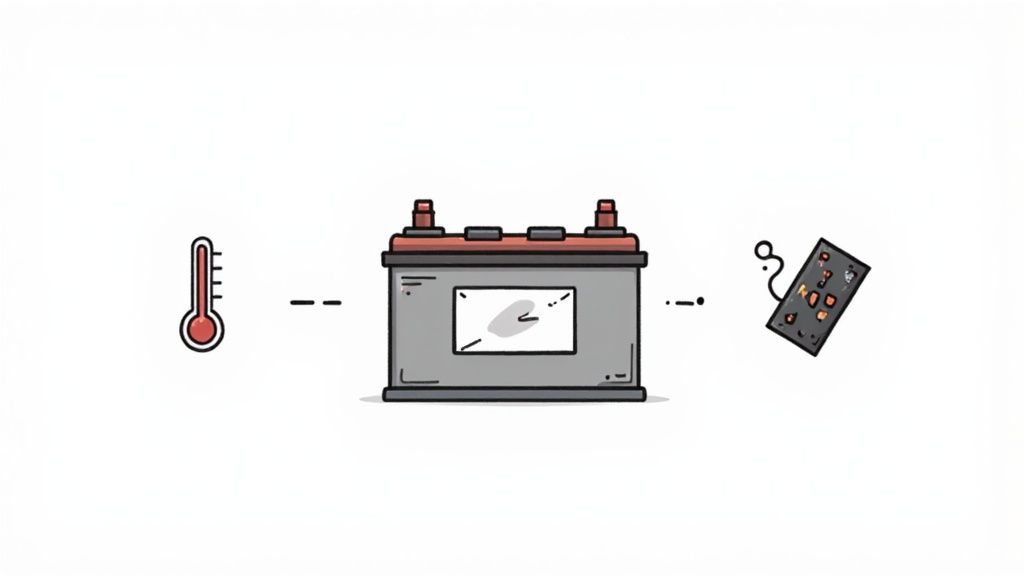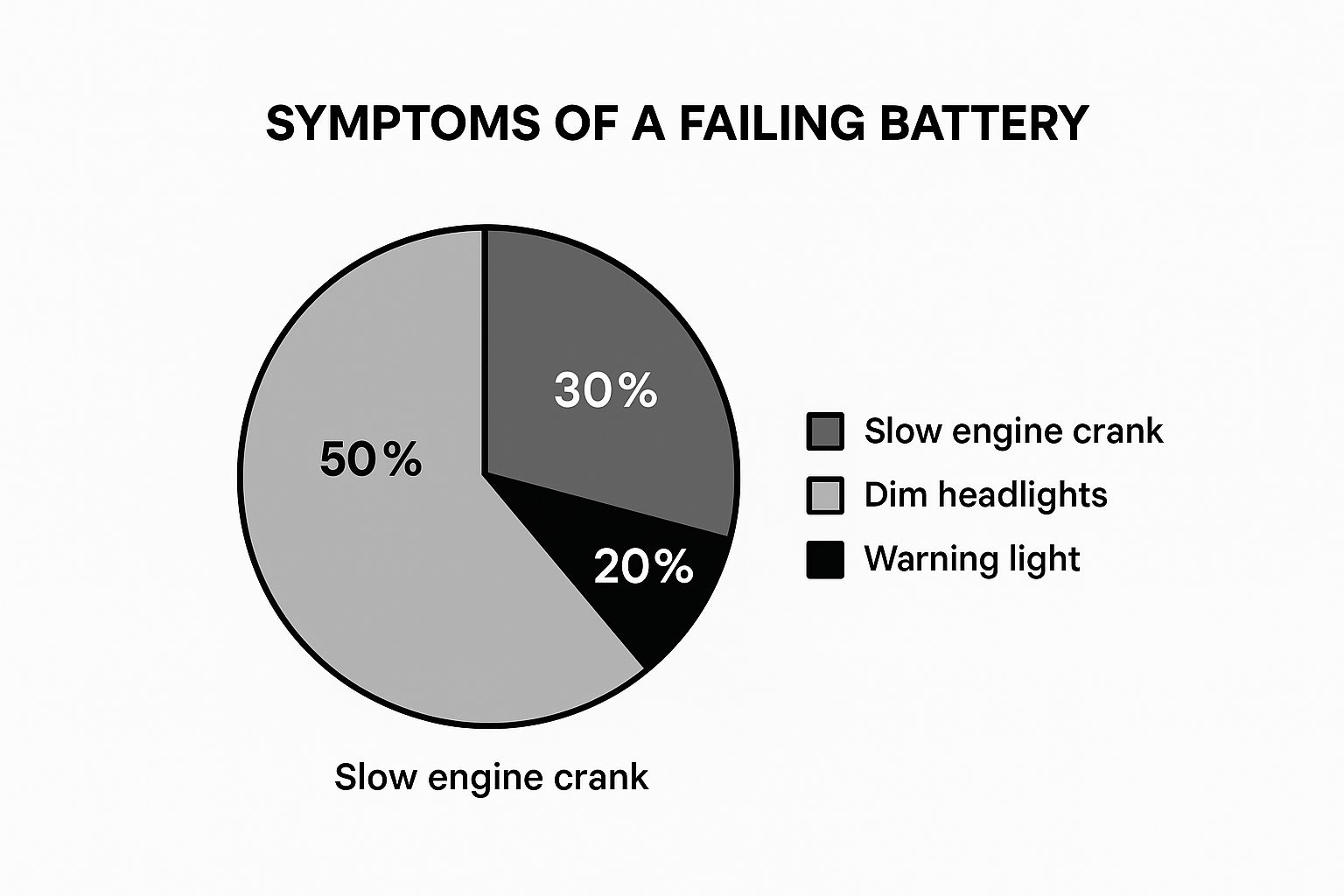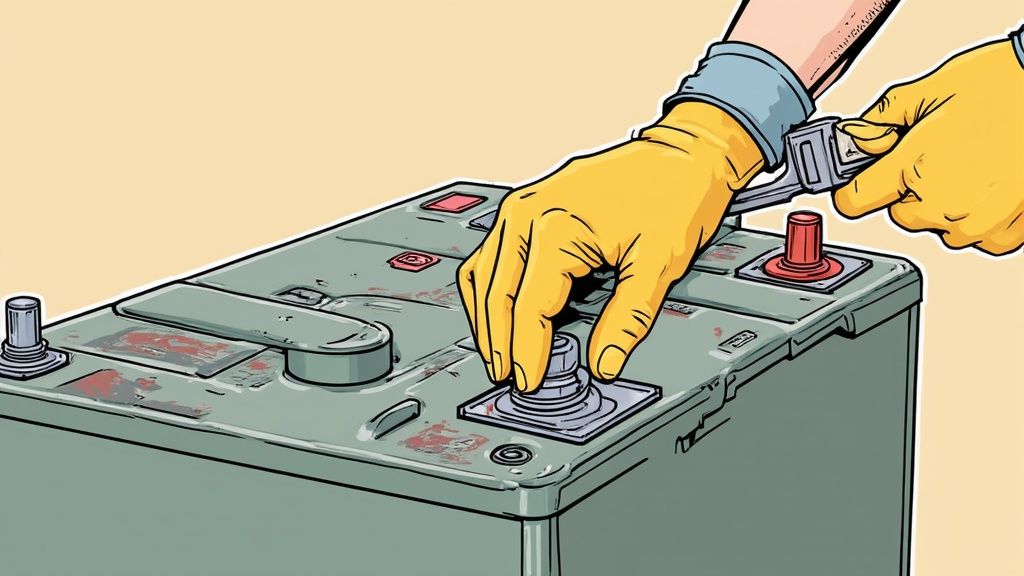
Kwik Kar Service Coupon
Get upto $20 OFF on all services.
How long should you expect your car battery to last? It's a question with a more complex answer than you might think. While some might claim a decade of battery life, the reality is much more nuanced, depending on several key factors. Just like a pair of shoes, a battery's lifespan depends heavily on how it's used.
One of the biggest factors influencing battery life is climate. Extreme temperatures, whether scorching hot or freezing cold, can significantly impact a battery's performance and lifespan. Excessive heat can evaporate battery fluid, causing internal damage. On the other hand, extreme cold slows down the chemical reactions needed for the battery to function. This means batteries in harsher climates often don't last as long as those in more temperate regions.
Driving habits also play a crucial role. Frequent short trips prevent the battery from fully recharging, potentially leading to sulfation. Sulfation is a buildup of lead sulfate crystals that hinders the battery's ability to hold a charge. It's similar to constantly topping off your gas tank without ever filling it up – it never reaches its full potential. Generally, car batteries last between 3 to 5 years, although some can last up to 7 years with proper care. Factors like the depth of discharge and charge cycles also affect lifespan. Learn more about these factors and how to maximize your battery's life here.
Like shoes designed for different activities, car batteries come in various types with varying lifespans. Economy batteries are cheaper upfront but often have shorter lifespans than premium batteries. Premium batteries use more durable materials and advanced technology, allowing them to handle tougher conditions and deeper discharges, ultimately lasting longer. This can translate to fewer replacements and potential cost savings in the long run. Thinking about cost versus longevity is common in many areas, like home improvements, where decisions such as Cabinet Refacing vs Replacement often come up.
Manufacturer-provided lifespan estimates are often based on ideal conditions, which rarely reflect real-world driving. Stop-and-go traffic, temperature fluctuations, and the use of various accessories all put additional strain on the battery. Therefore, it's best to view these estimates as guidelines rather than guarantees.
Regular maintenance is key to maximizing your car battery's lifespan. This includes regularly cleaning the terminals to prevent corrosion, checking electrolyte levels (in non-sealed batteries), and ensuring your car's charging system is functioning correctly. Taking these proactive steps can help your battery reach its full potential and prevent unexpected failures.

Beyond normal wear and tear, several hidden factors can dramatically shorten your car battery's life. Understanding these can help you avoid unexpected breakdowns and maximize your battery's lifespan. Just how long should a car battery last? Let's investigate some of the culprits silently draining your battery's power.
Many people think short trips are easy on their cars. Surprisingly, these quick errands can actually harm your battery's health. On short trips, the battery doesn't have adequate time to recharge after starting the engine and powering other systems. This leads to sulfation, a buildup of lead sulfate crystals that diminishes the battery's capacity.
Modern vehicles are also packed with electronics that constantly draw power, even when the engine is off. Think about the clock, the security system, and even the car's computer. This constant drain, combined with insufficient recharging time, contributes to premature battery failure.
Climate significantly impacts battery life. Extreme temperatures, both hot and cold, accelerate battery degradation. High temperatures can evaporate battery fluid, while low temperatures hinder the chemical reactions needed for optimal battery function.
Aftermarket accessories also put extra strain on your battery. Powerful sound systems, extra lights, and heated seats all increase electrical demand. If your charging system can't keep up, your battery's lifespan will likely be shorter. For more information about battery issues, check out this helpful resource: 7 Signs of a Battery Problem.
To illustrate how climate affects battery lifespan, let's look at the following table:
| Climate Type | Average Battery Lifespan | Primary Cause of Degradation |
|---|---|---|
| Hot (above 90°F) | 2-3 years | Fluid evaporation, increased internal resistance |
| Temperate (40-80°F) | 3-5 years | Normal wear and tear |
| Cold (below freezing) | 3-4 years | Reduced chemical reaction efficiency, increased viscosity of electrolyte |
This table demonstrates how extreme temperatures, both hot and cold, negatively affect a car battery's lifespan compared to temperate climates. In hot climates, fluid evaporation and increased internal resistance are the primary culprits, while in cold climates, the reduced efficiency of chemical reactions and increased viscosity of the electrolyte contribute to degradation.
Your weekend driving habits can also affect your battery's performance during the week. If your car sits idle for long periods over the weekend after a week of short trips, the battery slowly discharges, weakening it over time.
Conversely, a long drive can fully recharge your battery, offsetting the effects of those short weekday trips. This full charge helps maintain the battery's overall health and performance.
The good news is you can take steps to mitigate these battery-draining factors. Limiting short trips, ensuring your charging system works correctly, and minimizing the use of power-hungry accessories all contribute to a longer battery life.
If you frequently drive short distances, consider a battery maintainer or trickle charger. These devices keep your battery fully charged, especially during periods of inactivity. By understanding and addressing these often overlooked factors, you can maximize your battery's life and avoid inconvenient breakdowns.

Knowing the expected lifespan of a car battery is helpful. However, understanding the warning signs of a failing battery is crucial to avoid unexpected breakdowns. Your car often gives subtle clues long before the battery completely gives out. Recognizing these signals can save you time, money, and considerable frustration.
One of the clearest signs is the battery warning light on your dashboard. This light often signals a problem with the charging system, possibly the battery itself or the alternator. Ignoring this warning could lead to complete battery failure and leave you stranded.
Dimming headlights, particularly when idling or using other electrical accessories, are another indicator. The battery struggles to provide sufficient power, signaling a potential issue. If you frequently experience this, it might be time for a Battery Replacement.
Slow cranking is a common symptom of a weakening battery. This is the sluggish sound your engine makes when you turn the key. It means the battery is losing its ability to deliver the high current required to start the engine. While cold weather can cause a slow crank, persistent slow cranking, even in warmer temperatures, warrants attention.
Listen carefully to your morning start-up sound. A healthy battery delivers a strong, consistent crank. Changes in this sound, like a slower or weaker crank, can point to a declining battery. This is often the first noticeable sign of trouble. For more insights on battery replacement, see this helpful article: Signs Your Car Battery Needs Replacement – When to Call a Certified Automotive Professional.
Temperature significantly affects battery performance. Cold weather reduces battery power, potentially worsening existing problems. Slow cranking in winter might just be due to the cold, but if it continues into warmer months, suspect battery issues. Excessive heat can also speed up battery degradation.
A simple voltage test offers a more precise assessment of your battery's health. A fully charged battery should register around 12.6 volts. Readings below 12.4 volts suggest a possible problem. This proactive check can help you anticipate battery failure weeks in advance, providing ample time for replacement. By understanding these warning signs and performing periodic voltage tests, you can proactively address battery problems and avoid inconvenient breakdowns.
How long should a car battery last? The answer hinges on the type of battery: a traditional 12-volt lead-acid battery or the lithium-ion battery powering an electric vehicle (EV). This comparison explores the key differences in lifespan, degradation, and overall value.
Traditional car batteries generally last between 3 and 5 years, sometimes stretching to 7 with diligent maintenance. This shorter lifespan stems from factors like sulfation, temperature fluctuations, and the strain of starting the engine. EV batteries, however, are built for the long haul, typically lasting 15 to 20 years. This extended lifespan significantly impacts vehicle ownership costs and environmental impact.
The following infographic illustrates common warning signs of a failing 12-volt battery:

Slow engine cranking is the most frequent symptom (50%), followed by dim headlights (30%) and a warning light (20%). These signs indicate battery health issues needing prompt attention.
Both battery types degrade, but the processes and rates differ. Traditional batteries suffer from sulfation, a chemical process reducing capacity. EV batteries degrade primarily due to calendar aging and cycling.
Recent studies show EV batteries degrade at about 1.8% per year, an improvement from the previous 2.3%. This suggests EV batteries might last even longer than initially predicted, bolstering their role as a sustainable alternative to combustion engines. Learn more about EV battery health here.
Extreme temperatures affect both, but differently. Extreme heat can damage traditional batteries by evaporating fluids. High temperatures accelerate degradation in EV batteries. Cold reduces the efficiency of chemical reactions in both, impacting performance. However, advanced thermal management systems in EVs mitigate these effects, contributing to their longevity.
To further understand the key differences, let's look at a comparison table:
Traditional vs. EV Battery Comparison This table compares the key differences between traditional car batteries and electric vehicle batteries.
| Feature | Traditional Car Battery | Electric Vehicle Battery |
|---|---|---|
| Chemistry | Lead-acid | Lithium-ion |
| Lifespan | 3-7 years | 15-20 years |
| Degradation | Sulfation | Calendar aging and cycling |
| Temperature Sensitivity | Affected by extreme heat and cold | Affected by extreme heat and cold (mitigated by thermal management systems) |
| Warranty | Typically shorter | Typically longer |
This table highlights the significant differences in lifespan and degradation between the two battery technologies. EV batteries' robust construction and sophisticated management systems contribute to their extended lifespan.
Traditional battery warranties are considerably shorter than EV battery warranties. This reflects automakers' confidence in EV battery longevity, offering peace of mind to EV owners and contributing to the long-term value of electric vehicles.

We've talked about the typical lifespan of a car battery and the factors that influence it. Now, let's explore some practical ways to get the most out of your battery's lifespan. Forget the old wives' tales; these are proven techniques backed by experts.
Corrosion on your battery terminals can steal power. Regularly cleaning them with a simple baking soda and water solution can drastically improve conductivity and extend your battery's life. It's surprisingly simple yet incredibly effective.
This easy cleaning process prevents corrosion and helps maintain optimal battery performance.
Changing how you drive can add years to your battery’s life. Minimize short trips where the battery doesn't have a chance to fully recharge. This reduces the damaging effects of sulfation. Also, avoid leaving your car idle for extended periods to ensure a full recharge and maintain battery health.
If you have a seasonal vehicle, maintaining the battery during downtime is essential. A battery tender or trickle charger will prevent the battery from completely discharging, extending its usable life. This is especially important for vehicles stored during winter. Learn more in our article about How to Master Car Maintenance.
Parasitic drains happen when electronics draw power even when the car is off, slowly draining your battery. Identifying and fixing these drains can protect your battery and prevent inconvenient surprises. This might involve checking for faulty wiring or malfunctioning accessories.
A simple maintenance schedule can help even the busiest car owner keep their battery in great shape. Regular checks and cleaning, combined with mindful driving habits, can significantly extend your battery's lifespan.
Following this easy timeline will help your car battery perform reliably and reach its full lifespan potential. By following these simple yet practical strategies, you can take control of your battery's health and maximize its life.
Understanding car battery lifespan is a key concern for drivers. This pursuit is fueling remarkable advancements in battery technology, going far beyond simple improvements. We're on the brink of a major shift in how we power our vehicles. Let's explore some of the most promising innovations set to reshape the future of car batteries.
One of the most exciting developments is solid-state battery technology. Unlike conventional batteries that use liquid electrolytes, these batteries utilize a solid electrolyte. This seemingly small change has significant implications for battery performance and safety.
These advantages position solid-state batteries as a true game-changer, offering substantial improvements in safety, performance, and convenience.
Alongside solid-state technology, advancements in material science are also revolutionizing battery capabilities. Researchers are exploring innovative materials for both electrodes and electrolytes to improve energy density, charging speeds, and battery lifespan.
For instance, the use of silicon anodes is showing promise. These anodes can theoretically store up to ten times more lithium ions compared to the graphite anodes currently used. This could dramatically boost energy storage capacity. Furthermore, new electrolyte materials are being developed to enhance conductivity and stability, further optimizing battery performance.
While these innovations hold tremendous potential, the journey from laboratory research to practical application in vehicles takes time. Some next-generation technologies, such as solid-state batteries, are still in their early stages of development. However, other advancements, like improved electrode materials, are nearing commercial availability.
Recent studies offer encouraging insights into the lifespan of current EV batteries. Research from the SLAC-Stanford Battery Center suggests that these batteries may last up to 40% longer than previously projected. This indicates that current EV batteries might offer even greater value and longevity than initially expected.
These advancements are poised to influence maintenance requirements and costs. Solid-state batteries, with their increased lifespan and reduced degradation, could necessitate less frequent replacements, thereby lowering long-term ownership costs. However, the initial price of these new technologies is likely to be higher.
The wider adoption of next-generation batteries has the potential to transform the automotive industry. Longer-lasting, faster-charging batteries are expected to accelerate the transition to electric vehicles and reshape our understanding of vehicle power systems.
The future of car batteries is brimming with possibilities, thanks to numerous advancements on the horizon. While some technologies are still several years away, the progress being made points towards substantial improvements in battery performance, safety, and longevity. Ultimately, these advancements will reshape how we define the lifespan of a car battery.
Ready to ensure your current car battery is in optimal condition or explore options for your next vehicle? Visit Kwik Kar Oil Change and Auto Care in Richardson, TX. We provide expert battery services, ranging from testing and maintenance to replacement, using cutting-edge equipment and industry-leading practices. Schedule your appointment or learn more here.
CLICK LINK BELOW TO LEARN MORE ABOUT OUR SERVICES

Get upto $20 OFF on all services.